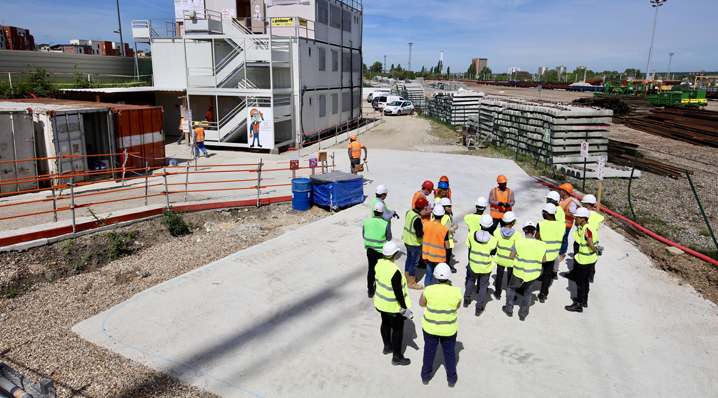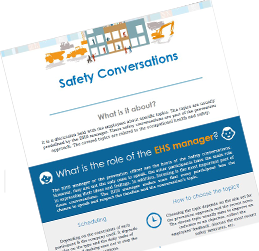
The effectiveness of a great health and safety program relies on good communication between, on one hand, managers and their employees and, on the other hand, the EHS managers and all the operational staff. Stepping out on the field and exchanging with the operational staff is the best feedback an EHS manager can ever have to improve the safety procedures.
These conversations will have a great impact on safety and health at work, especially when the EHS managers put themselves in the workers’ shoes!
The question remains: How to efficiently prepare these discussions? And what are the important topics to cover?
Setting the conversation framework
The safety conversations are important moments where information is exchanged amongst all the participants, and every single complaint and feedback is carefully considered.
The safety conversations should be ideally scheduled on a regular, daily or weekly basis. In addition, the topics or any other type of conversation should be well prepared in advance and should be coherent and structured, to engage in a calm and constructive discussion.
However, you should always contact the manager to schedule these discussions with the parties concerned and choose the ideal and appropriate time to do so.
Workers should feel that they can trust you during these conversations, and the more they feel comfortable and free to express their concerns and opinions the more they will be willing to be open to all safety topics. The ideal situation is to put yourself in their shoes and join them in the same working conditions that they go through every day. By doing so, your safety and security conversations will be more legitimate and you get to better understand the real working conditions.
On the other hand, if you remain distant from the tasks on the field, your interlocutors will feel that their reality is a thousand miles from yours.
In addition, there are many ways to engage with these safety conversations, for example during a coffee break, or just a walk-around tour with the employees and many other types of conversation approaches can be helpful. One thing is for sure, you will have to develop a trusting relationship to engage all the employees with your approach!
Deciding the topics to cover
Choosing the topic for the conversation is also important. You can list all the topics that come to your mind: news, internal or external events, feedback, working conditions, etc. Then, you should identify the most relevant for the corrective and preventive actions.
The chosen topics should be carefully selected and most importantly are situations that your colleagues/employees have already encountered. The group of people with whom you will engage in these safety conversations should be directly involved with the situation. If it is not the case, they won’t relate to the subject, then you will lose their interest and maybe even their trust.
You should never neglect some topics because they seem less relevant to you. For example, we often tend to ignore themes that are related to administrative risks. However, ergonomics at the workplace or stress management are important topics to consider.
You must be keen to plan events where everyone will feel personally involved, regardless of their daily tasks and professional background. You must be very careful not to excessively categorise your conversations because raising awareness of each and everyone’s difficulties is also important.
You have to make sure to carefully listen and devote time to your employees’ feedback. They can be the fuel for future topics to consider in your safety conversations. They can also be the best references for all the technical and organisational details you need for your topics.
The difference between what’s happening in the field and what is written in the procedures can sometimes be important. So, everything is not as clear as you think. The ideal way to learn about the safety conversation topics is to consult the concerned personnel before the scheduled conversation. This way, the conversation will be more accurate and relevant to the situation at hand. Your audience will be more attentive and receptive to your ideas, simply because you made them feel involved in the preparation of the conversation.
Here are some examples of safety topics that can be addressed in almost every company: Evacuation procedures, first reactions after an accident, PPE, safe operating of the fire extinguishers, main risks (fire, electric, etc.), ergonomics in the workplace, addictions, etc.

💡Download the infographic: 👉 "Tips for your Safety conversations (PDF)"
How to conduct as an EHS manager
Engaging in safety conversations is an important and crucial way for employees to express their ideas and feelings. Therefore, as an EHS manager your role is important, where listening to others should be mainly your concern, rather than occupying all the space. You should guarantee a safe and trusting environment where the employees can freely express their ideas. Your interventions should be limited, objective and compassionate. You should pay attention to all the negative criticism and handle them with grace. You must also guarantee the balance between objectivity and bad intentions to deviate the safety conversation from its aim.
You can also plan events and discussions between equal and different hierarchical levels in the company. Even if, sometimes, it is difficult to freely express ideas with the managers and our directors, however, it will come to you to install the free discussions to give faith to the employees to freely express themselves in front of their superiors. This will show how important installing a successful “communication” strategy in the company can greatly improve the safety, health and performance of all employees.
Evaluating the conversation
Safety conversation preparations are as important as the resulting feedback and their analysis. Once the discussions, the exchange of information and all the negative and positive feedback are gathered, as an EHS manager you should look at all of this data carefully. This will allow you to implement new safety measures or correct old ones.
Employees and colleagues look up to you, thanks to these conversations, as the person who will always be there for them in terms of security and safety measures. Taking into account their feedback can be the example you need to prove to the board of directors the necessity to invest in safety.
Adopting the “walking the walk” strategy and being able to involve the board of directors in this procedure will greatly help in making the employees feel invested and appreciated when they perform their daily tasks.
Understanding the situation in the field is always important, and all the feedback can serve as new data for future safety conversations to continuously improve the implemented processes.
Being an EHS manager, you are the main element for the success of the safety conversations. Beyond your objectives, always take into account the human factor in your decision-making and process organisation. Listening will be your greatest asset to succeed and obtain the best results from the safety conversations and achieve your goals!
To go further:
> Discover our Top 3 apps for EHS management on the BlueMarket.
. . .





.jpg?width=169&name=unnamed%20(7).jpg)